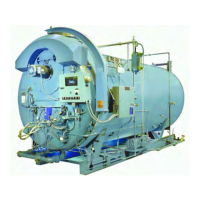Chapter 8 — Inspection and Maintenance
8-10 Part No. 750-184
that might be present. If there are cracks, replace the electrode since they
can cause grounding of the ignition voltage. Since carbon is an electrical
conductor, it is necessary to keep the insulating portion of electrode(s) wiped
clean if any carbon is present. Ammonia will aid in removing carbon or soot.
Check ignition cables for cracks in the insulation. Also see that all
connections between the transformer and the electrodes are tight.
H. GAS BURNER MAINTENANCE
The gas burner components should be inspected for evidence of damage due
to improperly adjusted combustion. Combustion adjustments should be
checked monthly. See Section Q in Chapter 6.
Check periodically for a proper seal between the end of the burner housing
and boiler refractory. Any deterioration of the seal should be corrected, as an
improper or poor seal allows air leaks, which can cause overheating or
burning of the burner housing.
Whenever the burner is removed, the diffuser, gas housing and gas spuds
(HTB model only) should be checked for any deterioration. Verify that the
diffuser skirt conforms to the bore of the burner housing so as to minimize
the amount of combustion air which bypasses the diffuser. If the burner is a
high turndown burner (HTB) model, check to see that the diffuser is properly
located in reference to the gas spuds. There should be 1/4” between the
edge of the diffuser fins and the gas spuds when the burner is installed.
Check to see that the diffuser fins do not interfere with the gas ports or gas
spuds in the burner housing. See Section V in Chapter 6 for more
information.
Check the electrode setting for any cracks that might be present on the
porcelain insulator. Replace the electrode if cracking is evident, since
cracking can cause grounding of the ignition voltage. Inspect the tip of the
electrode for signs of pitting, combustion deposits and wear, and dress as
required with a fine file.
Periodically remove the access plug from the gas pilot aspirator and clean
out any accumulated lint or other foreign material.
Check the ignition cables for cracks in the insulation. Verify that all
connections between the transformer and the electrode are tight.
I. MOTORIZED GAS VALVE
The motorized gas valve (Hydramotor) operating mechanism is completely
immersed in oil and little maintenance is required because of the sealed
design. However, proper operation should be checked on a routine periodic
basis.
Keep outer parts of the valve clean, especially the stem between the operator
and the valve. A nicked, scored or otherwise damaged valve stem can cause
leakage. Do not remove dust covers if installed.
The packing gland is of the O-ring type. If oil is noticed around the operator
base or if leakage occurs, repair by replacing any leaking O-rings and refilling
the actuator with oil.
If the actuator is sluggish or fails to operate, even after the oil level is
checked, replace the entire operator portion.

